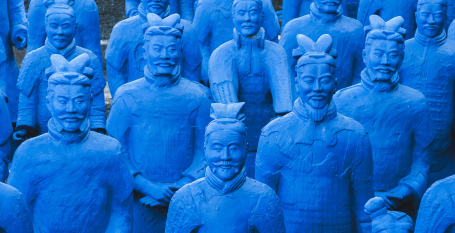It's being reported that Chinese authorities have recently shut down one of the last, most visible signs of LGBTQ activism in China - the LGBT Center in Beijing.
It’s the latest, and one of the most symbolic, acts of censorship in what appears to be a continuing campaign to erase the LGBTQ community from Chinese society.
A notice on the Center’s WeChat account Monday night confirmed the closure: “We very regretfully announce, due to forces beyond our control, the Beijing LGBT Center will stop operating today.”
Days before, the Center posted an article celebrating 15 years of work in the Chinese capital. The Center’s opening coincided with the Summer Olympic Games in Beijing in 2008, an opportunity Chinese leadership used to counter the country’s negative reputation around human rights.
In 2015, the Center worked with the United Nations Development Program to conduct an unprecedented nationwide survey on sexuality and gender. They’ve hosted film screenings, outreach events, and a long list of public speakers.
The Center evolved over its short history from a community gathering space to the headquarters for the well-known advocacy group LGBT Rights Advocacy China.
That group built a network of allied lawyers across the country and initiated nationwide campaigns pushing for policy changes, like recognizing same-sex marriage and LGBTQ diversity and inclusion, through targeted lawsuits.
The organization was shut down in 2021, when the founder was detained and authorities demanded the group be dismantled as a condition of his release. He has since relocated abroad.
What’s the history of homosexuality in China?
Let's take a look at China’s long history of celebrating same-sex desire.
Shang dynasty
The earliest records of homosexuality and same-sex relations in China date from the Shang dynasty era (c. 16th to 11th century BCE). During this period, homosexuality was largely viewed with indifference and usually treated with openness.
Zhou dynasty
There are a number of well-documented stories of homosexual love from the Zhou dynasty (c. 1046–256 BCE).
One example is the Duke Xian of Jin (reigned 676–651 BCE) who planted a handsome young man in a rival’s court in order to influence the other ruler with the young man’s sexual charm and to give him bad advice.
There was also the relationship of Mizi Xia and Duke Ling of Wei. There’s a story of Mizi Xia sharing his especially delicious peach with his lover. The Duke.King Anxi of Wei and his lover Lord Long Yang are another famous couple from this period.
Homosexuality was widely referenced during this period through popular literature. Poet Qu Yuan is said to have expressed his love for the ruling monarch, King Huai of Chu, through several of this works.
Han dynasty
Homosexuality and homoeroticism were common and accepted during the Han dynasty (202 BCE – 220 CE).
Emperor Ai of Han is one of the most famous Chinese emperors to have engaged in same-sex sexual activity. Historians characterise the relationship between Emperor Ai and his male lover Dong Xian as “the passion of the cut sleeve” after a story that one afternoon - after falling asleep for a nap on the same bed - Emperor Ai cut off Dong Xian’s sleeve rather than disturb him when he had to get out of bed. Dong was noted for his relative simplicity contrasted with the highly ornamented court, and was given progressively higher and higher posts as part of the relationship, eventually becoming the supreme commander of the armed forces by the time of Emperor Ai’s death.
Liu Song dynasty
Writings from the Liu Song dynasty era (420–479 CE) claim that homosexuality was as common as heterosexuality. It is said that men engaged so often in homosexual activity, that unmarried women became jealous.
Tang dynasty
During the Tang dynasty (618–907 CE) era, there were traditions of pederastic same-sex relationships, typically in Buddhist temples, among a young boy and an adult man.
Song dynasty
The earliest law against homosexual prostitution in China dates from the Zheng He era (1111-1118) of Emperor Zhao Ji in the Song dynasty (960–1279), punishing young males who act as prostitutes with 100 blows with heavy bamboo and a fine.
Ming dynasty
The Zhengde Emperor of the Ming dynasty (1368-1644) is believed to have had a homosexual relationship with a Muslim leader from Hami, named Sayyid Husain.
The Tianqi Emperor is believed to have had two private palaces – one for his female lovers and one for his male lovers.
Chinese homosexuals did not experience persecution which would compare to that experienced by homosexuals in Christian Europe during the Middle Ages, and in some areas - particularly among the merchant classes - same-sex love was particularly appreciated.
Qing dynasty
By 1655, Qing courts used the term ji jian (sodomy) to apply to homosexual anal intercourse. Society began to emphasise strict obedience to the social order, which referred to a relationship between husband and wife.
In 1740, an anti-homosexual decree was promulgated, defining voluntarily homosexual intercourse between adults as illegal.
Though there were no records on the effectiveness of this decree, it was the first time homosexuality had been subject to legal proscription in China. The punishment, which included a month in prison and 100 heavy blows with heavy bamboo, was actually the lightest punishment which existed in the Qing legal system.
Republic of China
In 1912, the Xinhai Revolution toppled the Qing dynasty and its explicit prohibition of ji jian was abolished by the succeeding states.
Heteronormativity and intolerance of gays and lesbians became more mainstream through the Westernisation efforts of the early Republic of China.
People’s Republic of China
Homosexuality was largely invisible during the Mao era because homosexuality was pathologised and criminalised. During the Communist Cultural Revolution (1966 to 1976), homosexuals were regarded as “disgraceful” and “undesirable”, and heavily persecuted.
All mentions to homosexuality in criminal law were removed in 1997.












 列印版本
列印版本




















讀者回應
請先登入再使用此功能。